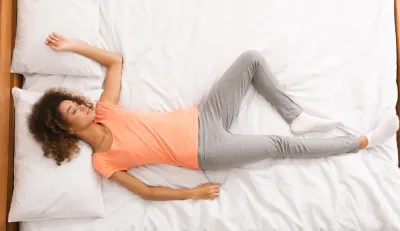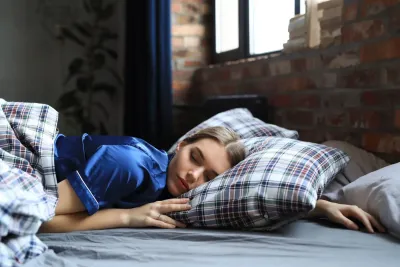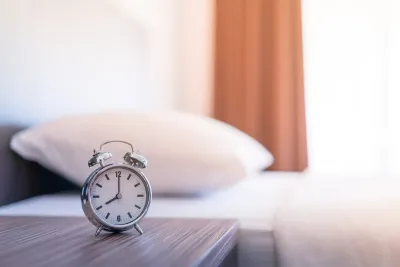
Key Takeaways
Your sleep position—whether you’re a Side Sleeper, Back Sleeper, or Stomach Sleeper—can influence pain levels, breathing, and overall sleep quality.
- Common sleep positions include the Fetal Position, Starfish, Soldier, Log Sleeper, Freefaller, and the classic Side, Back, and Stomach Sleeping styles.
- The Fetal Position and Side Sleeping (including Left Side Sleeping) often support better breathing and digestion, making them helpful for snoring, acid reflux, and pregnancy.
- Back Sleeping positions like the Soldier or Starfish can promote spinal alignment but may worsen snoring or sleep apnea for some individuals.
- Stomach Sleeping styles, including the Freefaller, may ease snoring but often cause neck or lower back strain due to poor alignment.
- Combination Sleepers shift between positions through the night, which can reduce pressure buildup but may require firmer pillows and stable temperature control.
- Selecting the right position can help minimize aches, improve airway stability, and support deeper, more restorative sleep.
Whether it’s on your stomach, your right or left side, your back, or even in a fetal position, the way you sleep can affect your health. Understanding the common sleeping position names people use today helps you better recognize how your posture affects rest.
The position you sleep in plays a major role in how your body works to repair itself during your slumber. It's common for people to wake up with new aches and pains daily due to their sleeping positions.
The truth is, however, there's no universally approved sleeping position. It depends on what you find comfortable and your personal health situation. Some positions relieve pain and trap heat, while others increase stiffness or pain in the back, shoulders, and arms, resulting in poor sleep. These are part of the sleeping position benefits and drawbacks people don’t always realize.
Did You Know: We spend a third of our lives sleeping—published in Work: A Journal of Prevention, Assessment & Rehabilitation, shows just how deeply sleep quality impacts overall health.[1]
Even The Cleveland Clinic, which examined the best possible sleep position, didn't select the best possible position. Instead, the Cleveland Clinic recommends rotating between your side and back, which is less stressful to the spine. [2] This fits with broader sleeping position terminology, which highlights how posture affects spinal health.
That movement is critical since fixed positions may increase back pain and symptoms. Always sleeping on the right side or left side can cause pain in your shoulders, or always sleeping on your stomach can trigger neck and back problems.
Want Deeper, Steadier Sleep in Any Position? - Save Up to 20%
Save during our Sale! The Chilipad keeps your sleep temperature consistent so you stay comfortable whether you sleep in the fetal, starfish, or any other position.
Different Sleeping Positions Names
Keep in mind that the best sleeping position is the one that encourages healthy, good spinal alignment from your hips to your head. This can help individuals who experience shoulder or back pain, acid reflux, or other health-related issues. Knowing what each sleeping position means can also help you troubleshoot discomfort more easily.
Did You Know: A stretching routine – even simple morning stretches or stretching before bed – can enhance your overall well-being. Plus, good alignment supports your body’s ability to settle into deeper, restorative stages of sleep.
We'll uncover some of the more popular sleep position names, including fun or quirky labels—yes, there are even funny sleeping position names and unique sleeping position names that have become popular online.

Fetal Sleeping Position
According to UK Professor Chris Idzikowski, the fetal sleep position offers the most benefits and is the most popular sleeping position. It makes sense. After all, we stayed in this position for at least nine months in the womb.
Read More: Tips for Sleeping During Pregnancy
One reason this position has gained such popularity is due to the fact it can help decrease your partner from snoring. If sleeping in the fetal position tends to hurt your hips, place a soft pillow between your legs to help ease the pressure.
Did you know that more women than men favor this position?
Sleep Statistic: According to Psychology Today, 41% of people sleep in the fetal position, while 37% believe it’s the best sleep position. [3]
Pregnancy Sleep Position
To help relieve pain, pregnant women, particularly in the later stages, can find relief by sleeping in the fetal position. MedlinePlus reports that the fetal sleep position is great for pregnancy as it can relieve pressure on the heart and back pain. [4] Learn more on how to sleep better when pregnant and explore some of the best sleeping positions.
Sleeping Tip: Specialized pregnancy pillows help support your back and legs while sleeping on your side, whether it's your right or left side.

Starfish Sleeping Position
If you sleep flat on your back with your arms overhead and legs stretched out to the sides, congrats—you’re a Starfish sleeper. The starfish isn’t just a quirky sleep position name; it comes with some serious perks. This sleep style can help reduce shoulder and lower back pain, protect your neck, and bonus, it’s one of the least likely positions to cause facial wrinkles. Sleep smart, sleep starfish.
But, similar to sleeping on your back, the starfish sleep position is prone to snoring and back pain, causing disrupted sleep. Sleep apnea can worsen by back sleeping. If this is your common position, starfish sleepers can put a small pillow below the knees to help reduce the back pain.
Overall, sleeping on your back in a neutral position is best, as you are less likely to experience back or neck pain.
Sleep Position Name: 5% of individuals choose to sleep in the starfish sleeping position. [5]
Yearner Sleeping Position
This position is described as sleeping on either your right or left side with both arms outward in front of your body as if they are reaching for something. Sleepers can wake up in pain if you have arthritis, similar to the log position. But, this position could be a good fit if you have breathing problems.
Side Sleeper Statistic: 13% of people said they sleep in the yearner position.
Freefall Sleeping Position
Freefall is a sleeping position where people sleep on their stomachs with their heads turned to the side and their arms wrapped around the pillow. It’s considered the second most popular position.
However, roughly 26% of people say that it’s the worst sleeping position.
Sleep Statistic: News-Medical reports 17% of people sleep in the freefall position. Approximately 7% of people sleep on their stomach. This is sometimes called the prone position. [6]
The Log Sleeping Position
This sleep position is one of the six primary sleeping styles. Defined as a side sleeping position, individuals sleep on their side with their arms to the side, similar to a log. With this position, sleepers are less likely to encounter numbness because their arms are down at their side.
This position is also an excellent option if you or your partner snores, but if you or your partner suffer from arthritis, you or your partner could wake up in discomfort.
Statistic: 6% of people like to sleep in the log position.
Soldier Sleeping Position
The soldier position is when you sleep on your back, and your arms are down close to your side. But this position can often lead to acid reflux, snoring, and a bad night's sleep.
Statistic: 11% of people prefer the soldier's sleep position. [7]

Spooning Position
Another sleeping side position is spooning. This is when the person in the back holds the individual in the front close to their body. Cuddling and spooning are signs of intimacy and stimulate the release of oxytocin. It's a hormone that decreases stress, promotes bonding, and helps you sleep more quicker. [8]
Give It a Try: All it takes is 10 minutes of cuddling to trigger the release of oxytocin.
Similar to other side positions mentioned above, there are advantages and disadvantages. A disadvantage is that the couple has the potential to wake up more frequently throughout the night. Plus, you're more likely to bump your partner in this position.
Sleeping on Your Back
If you’re not a back sleeper, don’t worry; roughly 8-10% of people sleep on their back. As we’ve learned from the above sleep positions, sleeping on your back can provide significant benefits for your health while achieving great sleep.
Benefits of Sleeping on Your Back
- Avoid sleep wrinkles
- Relieve sinus buildup
- Experience fewer aches and pains
- More irregular movements during the night
- Distributes your weight evenly
- Reduce heartburn
- Alleviate acid reflux
- Prevent shoulder stress
- Head, neck, and spine rest in a neutral position
When sleeping on your back, the following may occur:
- Increase the risk of sleep apnea
- Cause or worsen snoring
Side Sleepers
Based on research and studies, side sleeping is the most popular and familiar position. Similar to sleeping on your back, there are potential benefits such as:
- Relieves acid reflux
- Lowers the risk of GERD (it’s best to sleep on the left side)
- Relieves back and neck pain
- Decreases apnea symptoms
- Reduces the likelihood of snoring and breathing difficulties
- Improves brain health [9]
Did You Know: Research published in BMJ Open shows 60% of adults prefer sleeping on their side. [10]

Stomach Sleepers
Stomach sleepers are rare, with fewer than 10% of people preferring this position to sleep at night. Sleeping on your stomach can disrupt your spine's neutral position, causing neck, back, shoulder, and joint pain.
It's recommended that stomach sleepers sleep without a pillow or a very thin pillow. Using a thicker pillow can result in more strain on your neck.
With any position, there are some benefits of sleeping on your stomach which include:
- Lower risk of sleep breathing issues
- Relief from sleep apnea symptoms
- Reduced snoring

Sleep Position Review
In a 2025 study on sleep posture and back pain, results showed that although the side-lying position was commonly protective against back stiffness and pain, it was far from conclusive. [11]
Additionally, the study reported that there’s likely a relationship between sleep posture and spinal symptoms, “There were not enough high-quality studies to adequately answer our research question,” the study revealed. [12]
When it comes to sleep position, we're all unique, and there's no one right way to sleep. So the advice will vary based on your issues. For example, what works as the best position for neck pain will be different from the best sleep position for acid reflux.
Still, based on research, there is a slight advantage to side sleeping, and here’s why: it’s been shown to boost your cognitive abilities!
Final Thoughts: Choose Your Position
Now that you know the different sleep positions names, hopefully you will understand which is the best position for sleep. While sleeping on your side may be the best and most common sleep position, sleep quality matters most of all. The amount of restful sleep you get is critical because better sleep can increase productivity, prevent disease, enhance cognitive thinking, and aid weight loss.
Did You Know: There has been some research linking personality and sleep positions, but researchers cannot explain the connection between the two convincingly. [13]
The National Institute of Health points out that a chronic lack of sleep increases the risk of disorders, including cardiovascular disease, high blood pressure, obesity, diabetes, and depression.
Just remember, like any other health-related adjustments, it can take time for the body to adjust to a new sleep position, but it can be done. Be patient with yourself and use pillows to help prepare your body for the best position to achieve more restful sleep and achieve a good night’s sleep.
References
[1] Desouzart, G., Matos, R., Melo, F., & Filgueiras, E. (2015). Effects of sleeping position on back pain in physically active seniors: A controlled pilot study. Work (Reading, Mass.), 53(2), 235–240. View Study
[2] Best Sleeping Positions for Back, Neck and Shoulder Pain. (2021, December 17). Cleveland Clinic. View Resource
[3] Breus, Ph.D, Michael. “Your Sleep Position Affects Much More than You Think.” Psychology Today, 2019 View Study
[4] Problems sleeping during pregnancy: MedlinePlus Medical Encyclopedia. (n.d.). Medlineplus.gov. View Resource
[5] “BBC NEWS | Health | Sleep Position Gives Personality Clue.” Bbc.co.uk, 2025 View Resource
[6] Singh, Akanksha. “A Guide to Healthy Sleep Positions.” News-Medical.net, 27 Apr. 2022 View Resource
[7] Cary, Doug, et al. “Identifying Relationships between Sleep Posture and Non-Specific Spinal Symptoms in Adults: A Scoping Review.” BMJ Open, vol. 9, no. 6, 28 June 2019 View Resource
[8] Jain, V., Marbach, J., Kimbro, S., Andrade, D. C., Jain, A., Capozzi, E., Mele, K., Del Rio, R., Kay, M. W., & Mendelowitz, D. (2017). Benefits of oxytocin administration in obstructive sleep apnea. American journal of physiology. Lung cellular and molecular physiology, 313(5), L825–L833. View Study
[9] Lee, H., Xie, L., Yu, M., Kang, H., Feng, T., Deane, R., Logan, J., Nedergaard, M., & Benveniste, H. (2015). The Effect of Body Posture on Brain Glymphatic Transport. The Journal of neuroscience : the official journal of the Society for Neuroscience, 35(31), 11034–11044. View Study
[10] Cary, D., Briffa, K., & McKenna, L. (2019). Identifying relationships between sleep posture and non-specific spinal symptoms in adults: A scoping review. BMJ open, 9(6), e027633. View Study
[11] Saini, Yashita et al. “Relationship Between Sleep Posture and Low Back Pain: A Systematic Review.” Musculoskeletal care vol. 23,2 (2025): e70114. doi:10.1002/msc.70114. View Study
[12] Cary D, Briffa K, McKenna L. Identifying relationships between sleep posture and non-specific spinal symptoms in adults: A scoping review. BMJ Open. 2019 Jun 28;9(6):e027633. doi: 10.1136/bmjopen-2018-027633. PMID: 31256029; PMCID: PMC6609073. View Study
[13] Sleep position gives personality clue. (2003, September 16). News.bbc.co.uk. View Resource
Sleep Position Frequently Asked Questions
Which sleeping position is considered the healthiest?
Side sleeping is often recommended because it supports spinal alignment and reduces snoring. The left side in particular may improve digestion and circulation. However, the best position depends on comfort, health needs, and any existing pain.
What sleeping position helps with back pain?
Side sleeping with a pillow between your knees or back sleeping with a pillow under your knees can support spinal alignment and reduce pressure on your back. Stomach sleeping is usually least supportive for back pain.
Do different sleeping position names mean different health impacts?
Yes. Each sleep position affects the spine, airway, and pressure points differently. For example, the fetal position may ease tension, while the starfish or soldier positions may increase snoring. How you sleep can influence comfort, breathing, and recovery.
What are the most common sleeping position names?
The most recognized sleeping position names include the Fetal, Log, Yearner, Starfish, Soldier, Freefaller, Prone (stomach), Supine (back), and traditional left or right Side Sleeping. These names help describe how the body naturally settles during rest.
Is it okay to sleep in multiple positions?
Yes, it’s completely okay to sleep in multiple positions. Most people shift naturally throughout the night as the body adjusts for comfort, pressure relief, and temperature regulation. Rotating between positions is normal and can even help reduce stiffness by preventing long stretches of pressure on the same joints or muscles. The key is making sure each position still supports good alignment so you wake up rested—not sore.









